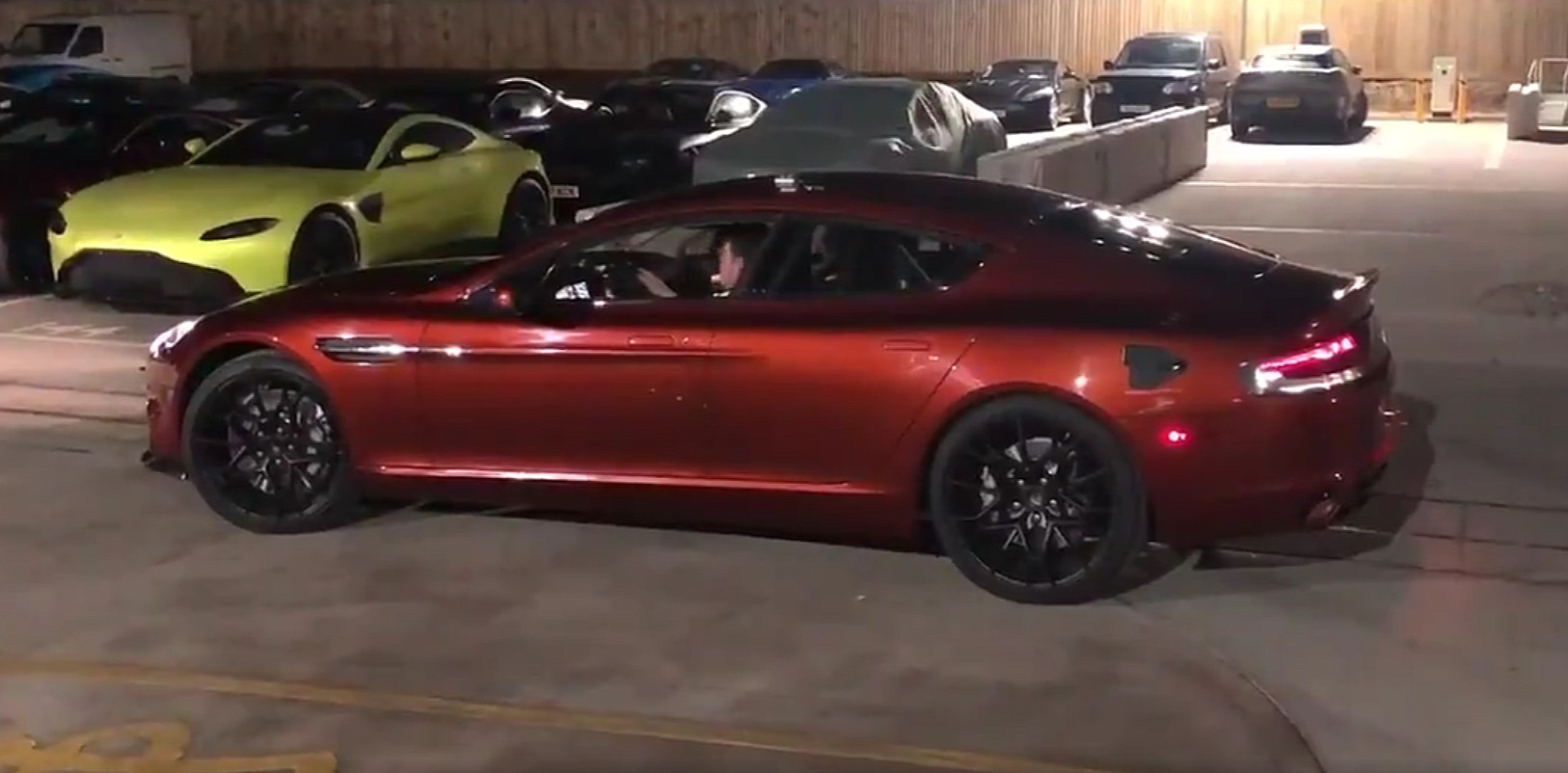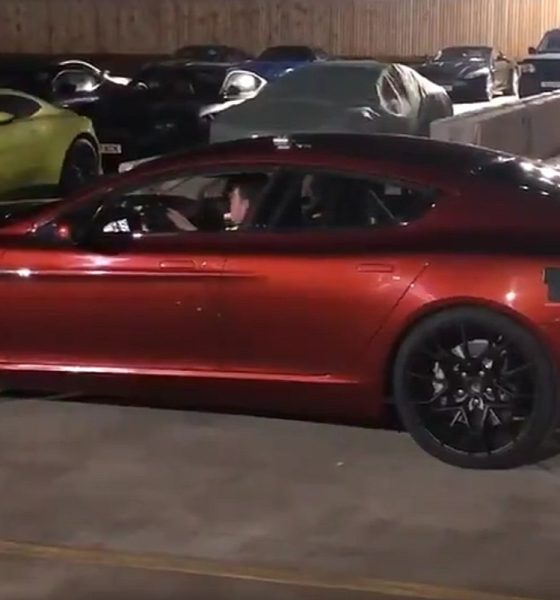

News
Aston Martin’s Rapide E electric car with 800V battery takes first steps in teaser video
With companies like Tesla proving that there is a very real demand for premium, high-performance electric cars, the auto industry’s veteran players are starting to embrace the EV transition. In the case of luxury automaker Aston Martin, the company has opted to start its all-electric push with a limited production run of its high-performance, Porsche Taycan-rivaling Rapide E.
Aston Martin President and Group Chief Executive Officer Andy Palmer recently took to Twitter to share a milestone in the Rapide E’s development. Palmer’s Twitter post featured a short video of a first validation prototype moving on its own for the first time with its 800-volt battery system. The Aston Martin CEO’s video was brief, but the short clip does provide an idea as to how the vehicle looks and sounds like when it’s moving.
Considering that the Rapide E in the video is a first validation prototype, it is quite understandable for the vehicle to move in a very deliberate pace. That said, it is quite interesting to hear what appears to be an audible whine from the car’s electric motors despite the Rapide E’s slow speed. It remains to be seen if the audible sounds from the EV’s motors are deliberate, but it does provide the Rapide E with a rather unique “exhaust note,” electric motors notwithstanding.
A moment of @astonmartin history. First Validation Prototype Aston Martin RapideE moves under its own power for the very first time with its breakthrough 800v battery. Great work from the development team which includes Williams Engineering. pic.twitter.com/b2mRaeCsNP
— Dr. Andy Palmer (@AndyatAuto) January 21, 2019
In the comments section of his post, the Aston Martin executive noted that the Rapide E’s 800-volt battery is a breakthrough in electric car technology, since it gives the vehicle a “significantly quicker fast charging time than any current technology.” Palmer also hinted at “another piece of Aston Martin history” being made on January 21, though the CEO noted that it would remain a “tightly-held secret” for the time being.
In a previous statement to Car and Driver, Palmer noted that the Rapide E would cater to a market that is beyond the premium segment being targeted by companies like Tesla. With a limited production run of 155 vehicles, the Rapide E is targeting customers who desire cars at the top end of the market.
“For me Tesla is a very credible competitor in the premium market, against Daimler, BMW, Audi, and the others. But they’re not in the (upper reaches of the) luxury market where we are. Most of the people who buy a Model S are buying it fully loaded. They’re not limited by their cash; they’re limited by the offer. They’re not a competitor of ours. We’re looking to those people looking for something above Tesla. That customer probably isn’t looking for Ludicrous mode. Our offer will have very credible acceleration, equal to a gasoline Aston Martin, but you’ll be able to drive the car rapidly all the way around the Nürburgring without it derating or conking out on you.”
Overall, it would be quite interesting to see how well the Aston Martin Rapide E stacks up against the competition. With vehicles like the Porsche Taycan Turbo and a possible updated Tesla Model S entering the market in the near future, the luxury carmaker’s flagship car would have to be excellent in all areas to stand out from the competition. In this sense, Aston Martin appears to have done its homework.
To help the company develop the vehicle, the luxury automaker opted to collaborate with Williams Advanced Engineering, the R&D and consultancy arm of the Williams Formula 1 team, to create the Rapide E’s electric powertrain. Aston Martin also noted that it is using an “800V battery electrical architecture with 65kWh installed capacity using over 5600 lithium ion 18650 format cylindrical cells.” The vehicle also packs serious power, with “two rear-mounted electric motors producing a combined target output of just over 610 PS and a colossal 950 Nm of torque.” In a press release last September, Aston Martin noted that the Rapide E would feature a range of over 200 miles per charge under the Worldwide Harmonised Light Vehicle Test Procedure (WLTP).
Production for the Aston Martin Rapide E is expected to begin in Q4 2019. The vehicle’s price has not been announced by the luxury automaker, though speculations suggest that the all-electric car would cost somewhere in the $200,000 to $250,000 range. Reports have hinted that all 155 units of the Rapide E have already been reserved.

Elon Musk
Elon Musk and Tesla AI Director share insights after empty driver seat Robotaxi rides
The executives’ unoccupied tests hint at the rapid progress of Tesla’s unsupervised Robotaxi efforts.

Tesla CEO Elon Musk and AI Director Ashok Elluswamy celebrated Christmas Eve by sharing personal experiences with Robotaxi vehicles that had no safety monitor or occupant in the driver’s seat. Musk described the system’s “perfect driving” around Austin, while Elluswamy posted video from the back seat, calling it “an amazing experience.”
The executives’ unoccupied tests hint at the rapid progress of Tesla’s unsupervised Robotaxi efforts.
Elon and Ashok’s firsthand Robotaxi insights
Prior to Musk and the Tesla AI Director’s posts, sightings of unmanned Teslas navigating public roads were widely shared on social media. One such vehicle was spotted in Austin, Texas, which Elon Musk acknowleged by stating that “Testing is underway with no occupants in the car.”
Based on his Christmas Eve post, Musk seemed to have tested an unmanned Tesla himself. “A Tesla with no safety monitor in the car and me sitting in the passenger seat took me all around Austin on Sunday with perfect driving,” Musk wrote in his post.
Elluswamy responded with a 2-minute video showing himself in the rear of an unmanned Tesla. The video featured the vehicle’s empty front seats, as well as its smooth handling through real-world traffic. He captioned his video with the words, “It’s an amazing experience!”
Towards Unsupervised operations
During an xAI Hackathon earlier this month, Elon Musk mentioned that Tesla owed be removing Safety Monitors from its Robotaxis in Austin in just three weeks. “Unsupervised is pretty much solved at this point. So there will be Tesla Robotaxis operating in Austin with no one in them. Not even anyone in the passenger seat in about three weeks,” he said. Musk echoed similar estimates at the 2025 Annual Shareholder Meeting and the Q3 2025 earnings call.
Considering the insights that were posted Musk and Elluswamy, it does appear that Tesla is working hard towards operating its Robotaxis with no safety monitors. This is quite impressive considering that the service was launched just earlier this year.
Elon Musk
Starlink passes 9 million active customers just weeks after hitting 8 million
The milestone highlights the accelerating growth of Starlink, which has now been adding over 20,000 new users per day.

SpaceX’s Starlink satellite internet service has continued its rapid global expansion, surpassing 9 million active customers just weeks after crossing the 8 million mark.
The milestone highlights the accelerating growth of Starlink, which has now been adding over 20,000 new users per day.
9 million customers
In a post on X, SpaceX stated that Starlink now serves over 9 million active users across 155 countries, territories, and markets. The company reached 8 million customers in early November, meaning it added roughly 1 million subscribers in under seven weeks, or about 21,275 new users on average per day.
“Starlink is connecting more than 9M active customers with high-speed internet across 155 countries, territories, and many other markets,” Starlink wrote in a post on its official X account. SpaceX President Gwynne Shotwell also celebrated the milestone on X. “A huge thank you to all of our customers and congrats to the Starlink team for such an incredible product,” she wrote.
That growth rate reflects both rising demand for broadband in underserved regions and Starlink’s expanding satellite constellation, which now includes more than 9,000 low-Earth-orbit satellites designed to deliver high-speed, low-latency internet worldwide.
Starlink’s momentum
Starlink’s momentum has been building up. SpaceX reported 4.6 million Starlink customers in December 2024, followed by 7 million by August 2025, and 8 million customers in November. Independent data also suggests Starlink usage is rising sharply, with Cloudflare reporting that global web traffic from Starlink users more than doubled in 2025, as noted in an Insider report.
Starlink’s momentum is increasingly tied to SpaceX’s broader financial outlook. Elon Musk has said the satellite network is “by far” the company’s largest revenue driver, and reports suggest SpaceX may be positioning itself for an initial public offering as soon as next year, with valuations estimated as high as $1.5 trillion. Musk has also suggested in the past that Starlink could have its own IPO in the future.
News
NVIDIA Director of Robotics: Tesla FSD v14 is the first AI to pass the “Physical Turing Test”
After testing FSD v14, Fan stated that his experience with FSD felt magical at first, but it soon started to feel like a routine.

NVIDIA Director of Robotics Jim Fan has praised Tesla’s Full Self-Driving (Supervised) v14 as the first AI to pass what he described as a “Physical Turing Test.”
After testing FSD v14, Fan stated that his experience with FSD felt magical at first, but it soon started to feel like a routine. And just like smartphones today, removing it now would “actively hurt.”
Jim Fan’s hands-on FSD v14 impressions
Fan, a leading researcher in embodied AI who is currently solving Physical AI at NVIDIA and spearheading the company’s Project GR00T initiative, noted that he actually was late to the Tesla game. He was, however, one of the first to try out FSD v14.
“I was very late to own a Tesla but among the earliest to try out FSD v14. It’s perhaps the first time I experience an AI that passes the Physical Turing Test: after a long day at work, you press a button, lay back, and couldn’t tell if a neural net or a human drove you home,” Fan wrote in a post on X.
Fan added: “Despite knowing exactly how robot learning works, I still find it magical watching the steering wheel turn by itself. First it feels surreal, next it becomes routine. Then, like the smartphone, taking it away actively hurts. This is how humanity gets rewired and glued to god-like technologies.”
The Physical Turing Test
The original Turing Test was conceived by Alan Turing in 1950, and it was aimed at determining if a machine could exhibit behavior that is equivalent to or indistinguishable from a human. By focusing on text-based conversations, the original Turing Test set a high bar for natural language processing and machine learning.
This test has been passed by today’s large language models. However, the capability to converse in a humanlike manner is a completely different challenge from performing real-world problem-solving or physical interactions. Thus, Fan introduced the Physical Turing Test, which challenges AI systems to demonstrate intelligence through physical actions.
Based on Fan’s comments, Tesla has demonstrated these intelligent physical actions with FSD v14. Elon Musk agreed with the NVIDIA executive, stating in a post on X that with FSD v14, “you can sense the sentience maturing.” Musk also praised Tesla AI, calling it the best “real-world AI” today.








